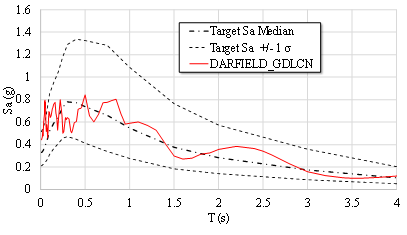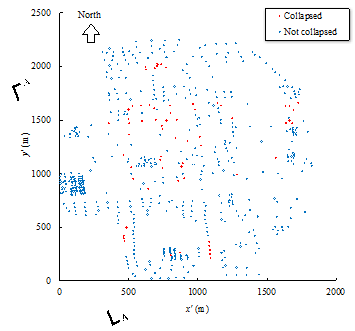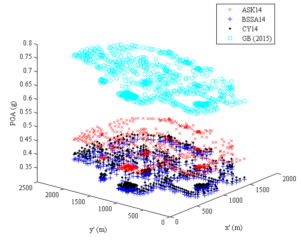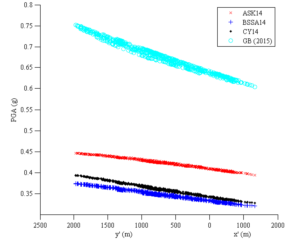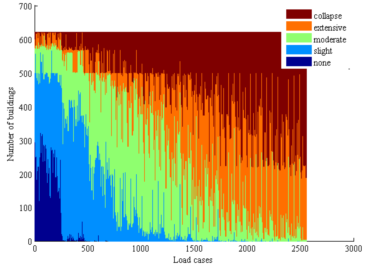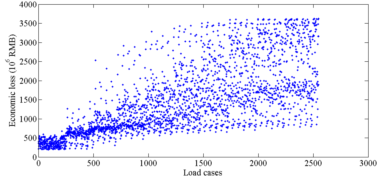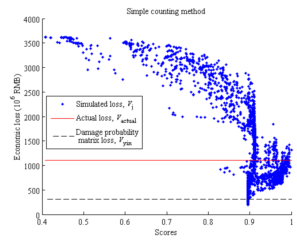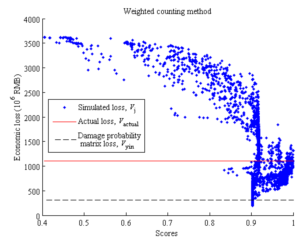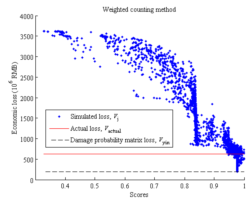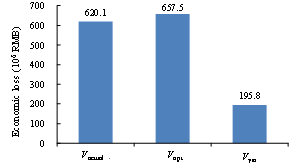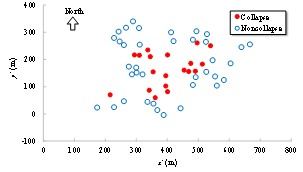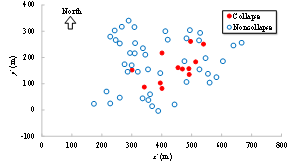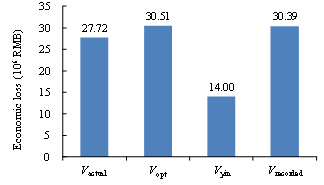Framework of near-real-time seismic loss estimation
The proposed framework of seismic loss estimation of regional buildings, incorporating the THA-based method and post-earthquake remote sensing image analysis techniques, consists of five components (Figure 1). (1) Identify collapsed and non-collapsed buildings by analyzing the post-earthquake remote sensing images, so as to obtain the building collapse scene of the disaster area. (2) Generate a large number of seismic analysis load cases. For example, use a large number of ground motions with different intensities and time histories as input. (3) Perform regional seismic damage simulation for each load case, resulting in a suite of simulation results. These results not only include the information of the collapse status of the building, but also include different damage states (i.e., none, slight, moderate, or extensive damage). (4) From the suite of simulation results, identify those that are mostly similar to the identified collapse scene as the optimal. (5) Estimate the seismic loss of the building using the optimal simulation results.
Much of the existing studies can be referred to for Components (1), (3), and (5). For the integrity of presentation, they are briefly introduced herein without detailed discussions. Note that Component (4) is one of the main focuses of this study, in which two similarity measures of building collapse distributions are proposed. Component (2) is also briefly described. It should also be noted that the framework proposed in this work (Figure 1) is generic and adaptable, i.e., each of the five components can be implemented through alterative means, not limiting to the implementation described in this work.
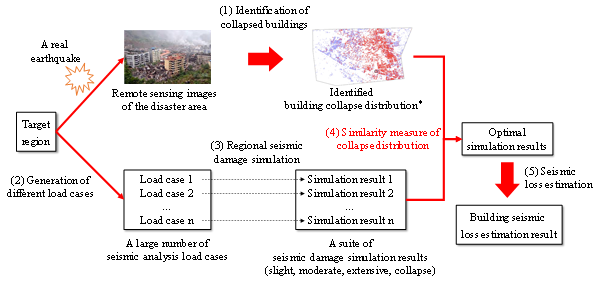
Figure 1. The framework proposed in this work. *Source of the building collapse distribution image: Gusella et al., (2005)
Identification of collapsed buildings
There exist many approaches to identify collapsed and non-collapsed buildings from the post-earthquake remote sensing images. For example, through crowdsourcing, the images are distributed to a group of people and collapsed buildings can be rapidly identified by human intelligence (Xie et al. 2016). Using image classification techniques (Li et al. 2014), collapsed / non-collapsed buildings can also be automatically identified.
It should be noted that existing studies on collapsed building identification from remote sensing images demonstrate the likelihood of having some omission errors (i.e. false negative rate). For example, Booth (2011) reported a 42% omission error in identification of the collapsed buildings during the 2010 Haitian earthquake; Yamazaki (2005) reported a 37.5% omission error for the 2003 Bam Earthquake, Iran. Notwithstanding, some published literature also show that the omission error can be reduced by using ancillary data (e.g. vector map of buildings), multi-perspective, and oblique images (Dong and Shan 2013). For example, Samadzadegan and Rastiveisi (2008) combined the QuickBird images and building vector maps for collapsed building identification subsequent to the 2013 Bam earthquake, leading to a reduced omission error of 25%; Turker and Cetinkaya (2005) used digital elevation models for the 1999 Izmit earthquake, Turkey, and the omission error was reduced to 16%. Therefore, identifying collapsed buildings from remote sensing images is both feasible and achievable.
Nevertheless, identifying non-collapsed damage states is a more challenging task. For instance, Foulser-Piggott (2016) attempted to identify the red tagged or yellow tagged non-collapsed buildings from the 2011 Christchurch earthquake, and the omission error was found to be 56%~86%. Note that currently there is no feasible solution to effectively reduce such an error.
Given the accuracy of the current remote sensing image identification techniques, this work thus suggests identifying collapse (rather than other refined damage states) from the remote sensing images. Extensive research and practical applications of remote sensing technologies have been well summarized and documented in several review articles (Rathje and Adams 2008, Dong and Shan 2013). As such, related topics are not discussed herein in detail. With respect to the case study of the 2014 Ludian earthquake presented in this work, the UAV aerial images from the China Earthquake Administration and news media, together with the building vector map were used. Visual interpretation (Dong and Shan 2013, Xie et al. 2016) was performed to identify the collapse situation of 56 buildings in the disaster area by human intelligence. Hence the identified collapse is consistent with the actual collapse situation.
It should be noted, however, that regional seismic loss estimation is a challenging issue. This work proposed an alternative approach, which is most suitable for cases with sufficient accuracy in collapse identification. With potential advancement of the remote sensing techniques, the omission errors are expected to be further reduced. For cases when the omission errors are significant, the predicted seismic loss will be underestimated, which would require further studies to be undertaken.
Generation of different load cases
The rationality of the THA results is influenced by (a) the building data, (b) the building models and parameters, and (c) the ground motion inputs. Firstly, with the advances in technologies such as big data and smart city, abundant urban building data become available (Qi et al. 2017). Secondly, with respect to the building models and parameters, the regional seismic damage simulation method developed by Xiong et al. (2016, 2017) with satisfactory modeling accuracy is adopted in this study. Thirdly, Lu et al. (2017) studied the uncertainty of the parameters of the structural models (e.g. the yield point, peak point, and soft point at the inter-story backbone curves) and its influence on the regional seismic damage simulation. Their results demonstrate that, assuming the parameters of the structural models of different buildings are independent, the uncertainty of those parameters has a small influence on the overall analysis results of a region. As a result, only ground motion uncertainty is considered when generating different load cases in this study. Therefore, the uncertainty of ground motion becomes the dominant factor influencing the accuracy of the THA results. Published studies also confirm that the randomness in structural seismic responses is mainly attributable to the uncertainty of the ground motion in particular when the seismic intensity is large (Kwon and Elnashai 2006).
In order to obtain a suitable ground motion input, the following strategy is adopted in this work: a number of different ground motions are used as input, so as to generate a series of THA load cases; then determine which ground motion input yields the building collapse results that are most similar to the identified collapse. For a region lacking sufficient ground motion input, a total of p different ground motion prediction equations (GMPE) are adopted, and a total of q ground motion records are selected for each GMPE, hence generating n = pq load cases.
Regional seismic damage simulation
In terms of regional seismic damage simulation, the method proposed by Xiong et al. (2016, 2017) is adopted in this work. In Xiong et al.’s study, low- and mid-rise buildings are simulated using the multiple degree-of-freedom (MDOF) shear model, while tall buildings are simulated using the MDOF flexural-shear model. Such numerical models of buildings are computationally very efficient. Based on the design process specified in the Chinese design codes and abundant experimental data, Xiong et al. (2016, 2017) proposed a model parameter determination method for reinforced concrete (RC) frame, reinforced masonry, unreinforced masonry, and RC tall buildings in China. With this method, the numerical models of buildings can be automatically established using basic building information (i.e. floor area, number of stories, height, structural type, construction period, and function). Xiong et al. (2016, 2017) compared the simulated building responses with the results of refined finite element models and experimental data. The comparisons validated the accuracy of the MDOF model and THA. For regions beyond China, it is suggested to use other parameter determination methods that are suitable for the particular region, such as the model parameter determination methods based on the HAZUS-database proposed by Lu et al. (2014) for the buildings in the United States.
Xiong et al. (2017) considered five different damage states, i.e., none, slight, moderate, extensive and collapse. For different structural types, different damage criteria were proposed. It is assumed that when the inter-story force or displacement exceeds a certain threshold, the structure reaches a corresponding damage state. Different from the fragility curves, such a threshold-based damage assessment is a deterministic approach. Xiong et al. (2017) compared the predicted damage states with the actual building seismic damage during the 2014 Ludian earthquake. Overall, the simulation agrees well with actual damage (Table 1). As a result, the parameters for damage assessment were treated as deterministic in this study.
Table 1. Comparison between the predicted damage states and actual damage states (Xiong 2017).
2 level underestimate | 1 level underestimate | Identical | 1 level overestimate | 2 level overestimate | |
Percentage number of buildings | 0 | 14% | 52% | 34% | 0 |
With respect to the soil-structure interaction (SSI) effects, for regular-height buildings on normal soils (not extremely soft), the SSI will not affect the structural responses significantly. It should be noted that in the proposed method, the simulated building collapse scenes are compared with the collapse scene identified from the remote sensing images of the disaster area. As a result, when evaluating the most suitable load cases, the SSI and the site-city interaction (SCI) effects are implicitly considered. Specifically, the identified optimal ground motion should be the one closest to the actual ground motion that is inputted to the building, which includes the SSI and SCI effects, instead of a free field ground motion without any SSI or SCI effects. This is supported by the result of Ludian earthquake validation in this study which shows that the estimated loss using the proposed method, Vopt, agrees well with the actual loss, Vactual. For the sites with soft soils or densely distributed high-rise buildings, studies show that the SSI and the SCI effects become more complex (Semblat et al. 2008, Isbiliroglu et al. 2015, Smerzini 2017). The shape and the attenuation of ground motions on such site may significantly differ from any ground motions or GMPEs specified for generating the simulated scenarios. In view of the above, it would be worthwhile to conduct further study and extend the applicability of the proposed method to cover the aforementioned cases.
Currently, the distributions of peak ground acceleration (PGA) or intensity (denoted as Shakemap) are widely used for loss estimations. For example, Huyck (2016) used ImageCat images to deduce the PGA Shakemap, and estimated the seismic loss based on ATC 13 (ATC 1985), which is a form of the damage probability matrix method (stage (1) of Method (2) described in Section “Introduction”). However, Shakemap relies on macroseismic intensities and empirical seismic damage observations, resulting in an average and subjective description of the hazard (Lang et al. 2012). Consequently, it may lead to considerable errors in replicating the actual seismic damage of individual structures. In addition, Shakemap mainly represents the amplitude of ground motions. Further, some other characteristics (e.g. duration and spectrum) of the ground motion input are difficult to be considered using Shakemap.
This study also compared the THA-based method and the damage probability matrix method. The damage probability matrix specific for Chinese buildings proposed by Yin (1996) is adopted in this study. This damage probability matrix has been widely used for the seismic loss estimation of past earthquakes in China. Note that the damage probability matrix method requires the use of the modified Mercalli intensity (MMI), and the relationship between PGA and MMI has shown to have a great uncertainty (Wald et al. 1999). In this work, the relationship suggested by the National Standard of China, “The Chinese seismic intensity scale” (GB/T 2008), is adopted, i.e. PGA of 0.09 g ~ 0.177 g corresponds to MMI of VII; PGA of 0.178 g ~ 0.353 g corresponds to MMI of VIII; and PGA of 0.354 g ~ 0.707 g corresponds to MMI of IX.
Similarity measure of collapse distribution
Among all the simulation results, in order to identify which one is most similar to the identified collapse distribution, each simulation result should be evaluated with a score. A higher score indicates a higher similarity with the identified collapse distribution, and those results with highest scores are identified as the optimal simulation results (Figure 2).
The similarity (or distance) measure quantifies the similarity between two objects, which plays an important role in pattern recognition, clustering, classification, and recommendation problems (Guo et al. 2013, Mahmoud 2011). In particular, binary similarity and distance measure is one of the most commonly used similarity measures. Since the building being of collapsed or non-collapsed is a binary event, the binary similarity and distance measure is thus considered in this work. Choi et al. (2010) summarized 76 binary similarity measures, including the widely used Jaccard similarity measure and Euclidean distance, etc. In this work, one of those measures is described in the Section “Evaluation of the similarity measure of collapse distribution” and denoted as the “simple counting method”. However, further discussions in that section show that binary similarity measures may not deliver reasonable outcomes for some cases. Hence the “weighted counting method” is proposed in this work taking into account the correction factors. Details are described in the Section “Evaluation of the similarity measure of collapse distribution”.
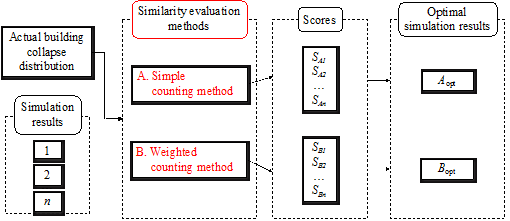
Figure 2. The flow chart of similarity measure of collapse distribution.
Seismic loss estimation
In this work, the building seismic loss is defined as the sum of the house damage loss Lh and decoration damage loss Ld. According to the National Standard of China, “Post-Earthquake Field Works-Part 4: Assessment of Direct Loss. (GB/T 2011)”, Lh and Ld are calculated using Eqs. (1) and (2), respectively:
![]() (1)
(1)
![]() (2)
(2)
where S is the building area (m2); Dh and Dd are the loss ratios of the house and decoration damages; given a damage state, their values are suggested in GB/T (2011), as shown in Table 2; P is the building replacement cost (RMB/m2, 1 RMB is approximately 0.145 USD in 2017), shown in Table 3 according to Yuan (2008); ![]() is the correction factor considering different economic conditions of different regions;
is the correction factor considering different economic conditions of different regions; ![]() is the building function correction factor;
is the building function correction factor; ![]() is the proportion of buildings with mid- to high-quality decoration; and
is the proportion of buildings with mid- to high-quality decoration; and ![]() is the ratio of the building decoration cost to the building construction cost. The values of
is the ratio of the building decoration cost to the building construction cost. The values of ![]() can be referred to Table A.1~A.4 in GB/T (2011).
can be referred to Table A.1~A.4 in GB/T (2011).
Table 2. Mean loss ratio of house damage and decoration damage under each damage state (GB/T 2011)
Damage state | None | Slight | Moderate | Extensive | Collapse | |
Loss ratio of house damage | 3 % | 11 % | 31 % | 73 % | 91 % | |
Loss ratio of decoration damage | Reinforced concrete (RC) | 6 % | 18 % | 43 % | 81 % | 96 % |
Masonry | 3 % | 13 % | 34 % | 74 % | 93 % |
Table 3. Mean building replacement cost (Yuan 2008) Unit: RMB/m2
RC frame | Masonry | Masonry-wood | Adobe-wood | Frame shear wall | Shear wall | |
Rural | 1200 | 825 | 550 | 425 | - | - |
Urban | 1300 | 850 | 850 | 600 | 1400 | 1700 |
It should be noted that this approach, which mainly works for regions in China, is only one of the commonly used seismic loss estimation methods. Alternative equations, consequence functions, and replacement costs that are different from Eqs. (1) and (2), and Table 2 and Table 3 have been proposed in many other studies (Bal et al. 2008, FEMA 2012a, Chaulagain et al. 2016, Martins et al. 2016). In practice, different methods are applied to different regions other than those in China. Taking the regions in USA as an example, the consequence functions and replacement costs can be referred to Tables 15.2~15.6 and Table 3.6 provided in the HAZUS report (FEMA 2012a). As described above, using different seismic loss estimation methodologies will not change the conclusions of this work.






